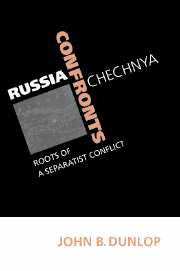3 - The eruption of the “Chechen Revolution”
Published online by Cambridge University Press: 06 January 2010
Summary
[U]nlike in other [autonomous] republics, the idea of breaking away from Russia was popular among most Chechens [in 1991].
North Caucasus area specialist Ol'ga Vasil'evaIn order to understand the causes underlying the kaleidoscopic “Chechen Revolution” of 1990–91 and the concomitant rise to power of General Dzhokhar Dudaev, one needs to look closely at a number of interlinked economic, social, and demographic processes occurring in the Chechen–Ingush ASSR during the Brezhnev-to-Gorbachev years (1964–91). As the Tishkov group has noted, within the republic of Checheno-Ingushetiya during this period: “[T]here had taken place a kind of division of the economy into two sectors: a ‘Russian’ one (the oil-extracting industry, machine-building, systems of social maintenance, and infrastructure) and a ‘national’ one (small village production, seasonal work, and the criminal sphere – and the ranks of this second ‘national’ sector were continually increasing as new contingents of young people came of working age).”
Factors behind the “Chechen Revolution”
As a result of the formation of these two sectors – i.e., a “Russian” one and a “national” one – industry and transport were experiencing a severe labor shortage in Checheno-Ingushetiya at the same time that village agriculture ceased being able to absorb the growth in labor resources taking place among the core rural population of Chechens and Ingush. Tens of thousands of unemployed villagers composed what came to be known as “surplus rural populace.”
- Type
- Chapter
- Information
- Russia Confronts ChechnyaRoots of a Separatist Conflict, pp. 85 - 123Publisher: Cambridge University PressPrint publication year: 1998



